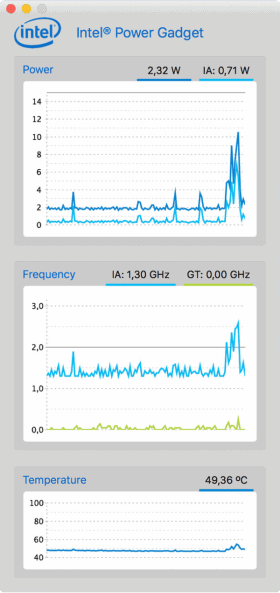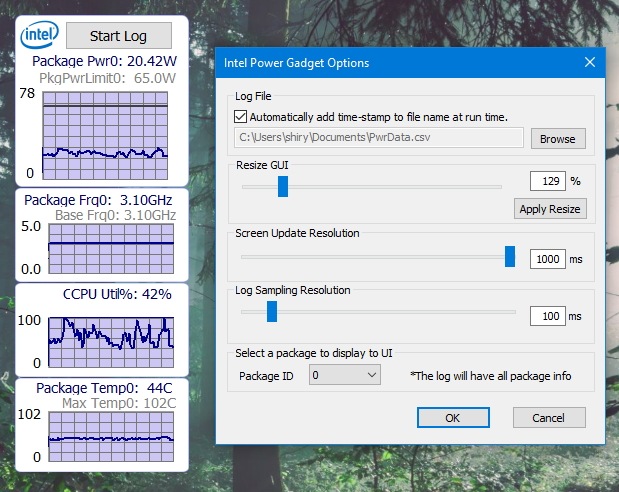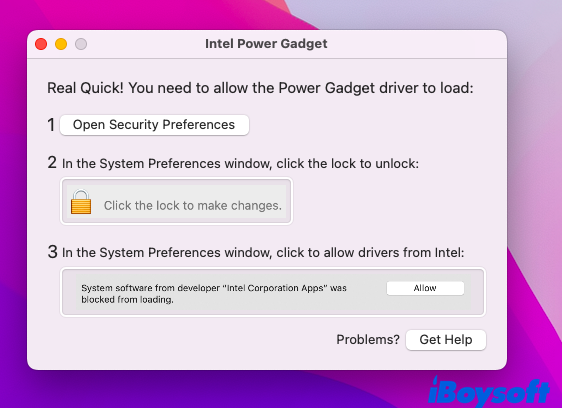

- Intel power gadget problems full#
- Intel power gadget problems pro#
- Intel power gadget problems code#
- Intel power gadget problems free#
Intel power gadget problems pro#
Running a single thread on just the E cores of an M1 Pro gives a loop rate of 48 Mloops per second, which is reported as 98.7% CPU. For each of these, I’ve calculated the rate at which the chip processes loops of floating point calculations, and compare those with the % CPU shown in Activity Monitor. Using my test app AsmAttic together with Activity Monitor and a command tool which reports core residency and frequency, powermetrics, I’ve got some examples to show how misleading % CPU can be. As that’s not taken into account when reporting % CPU, there’s a big difference in performance which remains invisible.
Intel power gadget problems code#
A single thread is likely to be run at a frequency of around 972 MHz, but two or more see that boosted to the E core maximum of 2064 MHz, which should run code twice as fast. When testing, frequency changes are most apparent in M1 Pro/Max chips when running background tasks on the E cores alone.
Intel power gadget problems full#
The second P cluster can spend much of the time almost shut down, at a frequency of 600 MHz and in full idle, until its cores are recruited for a heavy load. The M1 Pro/Max has three clusters: two E cores in their own cluster, and two clusters of four P cores each. The original 8-core M1 has one cluster of four E cores, and one of four P cores. Both the original M1 models and the M1 Pro/Max group their cores into clusters, which are managed by macOS.
Intel power gadget problems free#
When background processes concerned with Spotlight indexing are taking a high % CPU, you’ll see that this is almost entirely on the E cores, leaving the P cores free to run your apps without any significant penalty from macOS.Īnother important feature of M1 Macs is that their cores run at a wide range of frequencies (clock speeds) according to the nature and amount of their load. You can watch this in action by opening Activity Monitor’s CPU History window, where the active residency is shown for each core separately. This is very important in an M1 Mac, because most system processes are confined to the E cores, and almost all apps and related user processes can run on either P or E cores, preferring the P cores when possible. As far as % CPU goes, though, they’re all the same. They differ in the number and capability of the units within each core, and their maximum frequency.

M1 chips contain two different types of core, those designed for Efficiency (E), and those for Performance (P). No distinction is made between E and P cores Put the other way round, if you see % CPU at 40% and your Mac has eight cores, that’s an average active residency of just 5% on each core. Furthermore, when an Intel core uses hyperthreading to boost its performance, scale maximum for % CPU doubles: with eight cores in full hyperthreading, that comes to a total of 1600%. This is the total for all CPU cores, so if your Mac has eight cores, the scale maximum for % CPU is 800%. So if a core were completely idle, active residency would be 0% when no idle cycles were recorded, it would be 100%. As far as I can tell, the figure given is the total of ‘active residency’ for all cores, meaning the percentage of core cycles that aren’t spent in idle. Unfortunately Apple doesn’t appear to define what the % CPU column means, other than stating that it’s “processor capability”. This article tries to explain that what you’re looking at probably isn’t as bad as you think, and how it can be particularly misleading on an M1 Mac.

If we see anything over about 20%, we get alarmed and start asking questions, as if % meant out of a hundred. The first place most of us turn to when we’re concerned about the performance of any Mac is Activity Monitor’s CPU tab, where we can see which processes are hogging the cores.


 0 kommentar(er)
0 kommentar(er)
